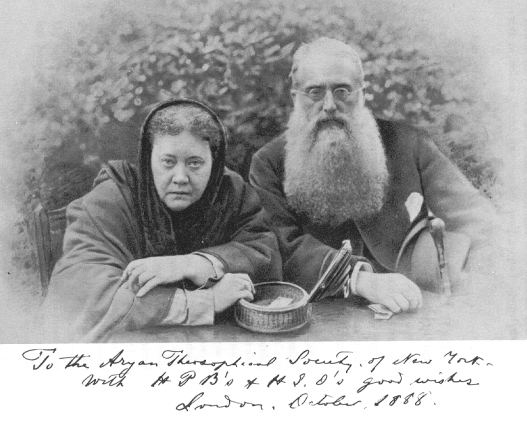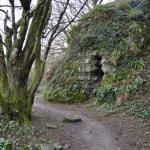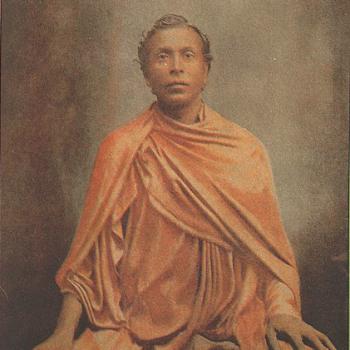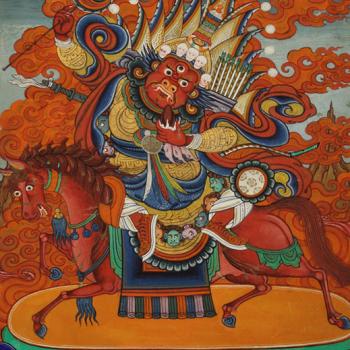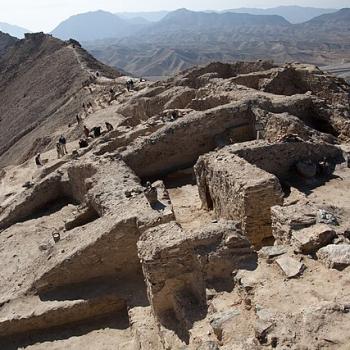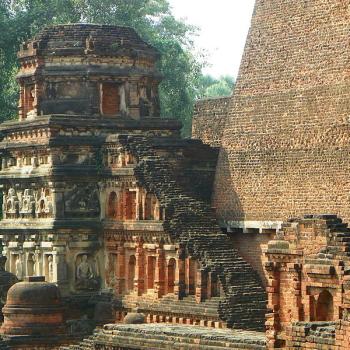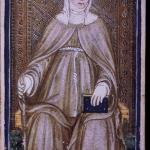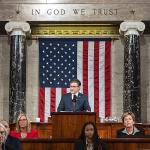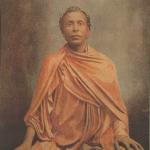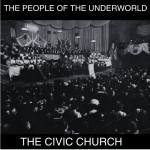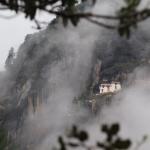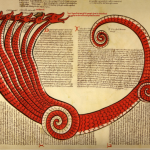In front of the main railway station in Colombo, Sri Lanka, is a golden statue of Henry Steel Olcott (1832-1907). Olcott was a U.S. Civil War veteran and insurance lawyer from Orange, New Jersey. And every year on February 17, Buddhist monks gather at the statue to lay a wreath and make offerings. Similar ceremonies are held in temples and schools throughout Sri Lanka. These are in grateful remembrance of Olcott, possibly the most interesting man you never heard of.
In Sri Lanka, Henry Steel Olcott is a hero. He was a pivotal organizer of a revival of Buddhism in what was then the British Crown Colony of Ceylon. The impact of this revival sent waves throughout all of Buddhist Asia. In time the revival expanded into an independence movement and the establishment of the nation of Sri Lanka. Olcott’s image has appeared on postage stamps, and students of Sri Lanka’s Buddhist colleges compete in the annual Henry Steel Olcott Memorial Cricket Tournament.
Henry Steel Olcott was born in Orange, New Jersey, to a devout Presbyterian family descended from Puritans. After attending the College of the City of New York he entered Columbia University. The failure of his father’s business caused him to withdraw from Columbia without graduating. He went to live with relatives in Ohio and developed an interest in farming. He moved back east, to New York, and in 1858 he became the agriculture correspondent for the New York Tribune. In 1860 he married the daughter of the rector of Trinity Episcopal Church in New Rochelle, New York.
In 1861 the U.S. Civil War began, and Olcott enlisted in the Signal Corp. After some battlefield experience he became a Special Commissioner for the War Department, investigating corruption in recruitment offices. He was promoted to the rank of Colonel and assigned to the Department of the Navy. His reputation for honesty and industriousness earned him an appointment to the special commission that investigated President Abraham Lincoln’s assassination. After the war he returned to New York to study law. He was admitted to the bar in 1868 and built a successful practice specializing in insurance, revenue, and customs law. And if you are wondering how this paragon of 19th century American respectability became a Buddhist organizer in Sri Lanka, do keep reading.
Henry Steel Olcott and Madame Blavatsky
Olcott had developed an interest in spiritualism as well as farming while he was living with relatives in Ohio as a young man. Spiritualism — not to be confused with spirituality — is the belief that there can be communication between the living and the dead, and the 19th century was its golden age. This interest in spiritualism intensified after the Civil War. Mediums were an entertainment phenomenon, drawing big, paying audiences for elaborate displays of “evidence” from the Great Beyond. And séances were all the rage. See “Talking With the Dead in 19th Century America” for more background.
After the war Olcott was making a comfortable living with his law practice, but he still liked to write for newspapers now and then. In 1874 he traveled to Vermont to cover reports of ghosts appearing in a farmhouse. While there, he met a famous spiritualist named Helena Petrovna Blavatsky, often called Madame Blavatsky. Blavatsky (1831–1891) was a phenomenon in her own right. She was both an original and visionary spiritual thinker and an obvious flimflam artist at the same time. A Russian national, she married a much older man when she was 17 and shortly after ran away. According to her own account, over the next few years she traveled extensively through Turkey and into central Asia and eventually Tibet. There, she said, she received many secret teachings from enlightened masters — “mahatmas” — and translated ancient texts that had long been kept hidden in a monastery. There is no record in Tibet of Blavatsky having been there. However, as a child she did spend some time in Kalmykia, where Tibetan Buddhism is practiced and where she probably was exposed to it. But throughout her career as a spiritual teacher she insisted she was receiving letters from “adepts” through the astral plane somehow. These, she said, were coming from the masters of the Great White Brotherhood who were guiding human destiny. Make of that what you will.
Olcott became one of Blavatsky’s most devoted disciples. By then he was divorced — his immersion in the spiritualist movement had something to do with this, I believe — and he began to divert profits from his law practice into Blavatsky’s projects. Together Blavatsky and Olcott founded the Theosophical Society in 1875 and began publishing a journal called Isis Unveiled. In 1879 they and the Society’s headquarters moved to Adyar, India. And in 1880 the pair visited the British Crown Colony of Ceylon.
The Buddhist Revival
To fully appreciate how Blavatsky and Olcott were received in Ceylon you need to know a little more about Ceylon, today’s Sri Lanka. Buddhism had been the dominant religion of the island since the 3rd century BCE. I believe Buddhism has been continually and consistently practiced in Sri Lanka longer than anywhere else on our planet. But Portuguese ships first landed there in 1505, and from the 16th century Ceylon had been partly or entirely controlled by European powers — first Portugal, then Holland. Then in 1796 control passed from the Dutch to the British. All of the colonial governments had oppressed Buddhism in one way or another. (See, for example, “A Tale of the Buddha’s Tooth.”) The British government encouraged Christian missions to Ceylon, believing Christianity would have a “civilizing” effect on the “natives.” The missionaries opened schools throughout the island to convert the people of Ceylon to Christianity and teach them English. By the 19th century, Buddhist institutions in Ceylon were moribund, and the people knew little of the spiritual tradition of their ancestors.
Then came the Buddhist revival. It was begun by a charismatic young monk named Mohottivatte Gunananda (1823-1890). Gunananda traveled throughout Ceylon calling for a return to Buddhism to rapt audiences. In 1866 Gunananda began challenging Christian missionaries to debate him on the relative merits of their religions. In a series of debates held in 1866, 1871, and 1873, Gunananda debated the foremost missionaries of Ceylon. To the Sinhalese, Gunananda was the clear winner each time. So by the time Olcott and Blavatsky visited Ceylon, this Revival was well underway.
Olcott and Blavatsky arrived in Colombo on May 16, 1880. The Sinhalese expected them. Olcott wrote of that day, “A huge crowd awaited us and rent the air with their united shout of Sadhu! Sadhu! A white cloth was spread for us from the jetty steps to the road where carriages were ready, and a thousand flags were frantically waved in welcome.” A few days later, Olcott and Blavatsky knelt before a huge statue of the Buddha and vowed to keep the Five Precepts and take the Three Refuges. This is an ancient ceremony that marks a commitment to the Buddhist path. Olcott and Blavatsky had formally become lay Buddhists, and by doing so also became folk heroes in Ceylon. Olcott in particular had impressed the Sinhalese with his oratory. They called him the White Buddhist.
Olcott’s Contributions to Ceylon
It has to be said that while Blavatsky’s and Olcott’s Theosophy did borrow quite a bit from Buddhism, it was not itself Buddhist. It was more of a mashup of Asian spiritual traditions held together by American Transcendentalism. Even so, on this first trip to Ceylon Olcott founded the Buddhist Theosophical Society for the diffusion of Buddhist knowledge. The BTS would build several Buddhist schools, some of which are prestigious colleges today. As time went on Olcott’s attention turned more and more to Ceylon, while Blavatsky’s did not. This was the beginning of a rift between the two that is an interesting story in itself, but which will have to be saved for another post.
Olcott returned to Ceylon in 1881 — against Blavatsky’s wishes — and together with Mohottivatte Gunananda he traveled the western provinces of Ceylon in an elaborate ox cart of Olcott’s design that must have been the forerunner of today’s travel trailers. Villagers flocked around to gawk the traveling contraption and stayed to hear Gunananda and Olcott extol the virtues of Buddhism. On this trip he also raised money for Buddhist schools and published a “Buddhist catechism” to instruct children in Olcott’s version of Buddhism. On this and subsequent trips to Ceylon, Olcott became recognized as a leader of the Buddhist Revival. In 1884 he traveled to London to lobby the government for more freedom of religion for Sinhalese Buddhists. British colonial officials agreed to loosen regulations of public Buddhist worship and to officially recognize Wesak, the holy day commemorating the birth, enlightenment, and death of the Buddha.
In his later years Olcott also visited other Buddhist countries on lecture tours. He designed an international Buddhist flag. He tried without success to organize an international Buddhist league of some sort. Meanwhile, Helena Blavatsky had been called out as a con artist and spent the rest of her years in Europe, where she wrote and published her book The Secret Doctrine on occult philosophy. This book was a huge success and is still in print. After Blavatsky died in 1891 the Theosophical Society soon had new leadership, who froze out Olcott. But Olcott had found his life’s work in Asia nonetheless. He died in Adyar, India, in 1907.
Postscripts
A Sinhalese protégé of Olcott’s and Blavatsky’s named David Hewavitharane, who renamed himself Anagarika Dharmapala (1864-1933), would continue Olcott’s work and expand upon it. Among other things, Dharmapala became a leading figure in the independence movement against British rule in Ceylon.
In 1950 the World Buddhist Fellowship was established. The Fellowship adopted Olcott’s Buddhist flag as its emblem.
On September 10, 2011, a statue of Henry Steel Olcott was unveiled at a Buddhist temple near Princeton, New Jersey. The statue is a replica of the one at the train station in Colombo. Most of the money to pay for the statue came from alumni of the many “Olcott schools” in Sri Lanka.
Over the past century or so the Theosophy movement appears to have become less about the occult and more about open-minded spirituality. If that’s what you’re into, don’t hesitate to check them out.
